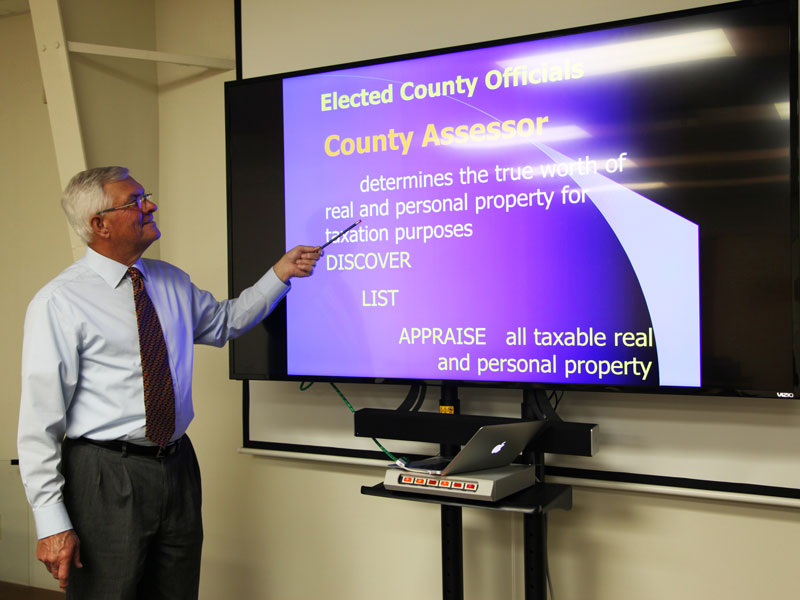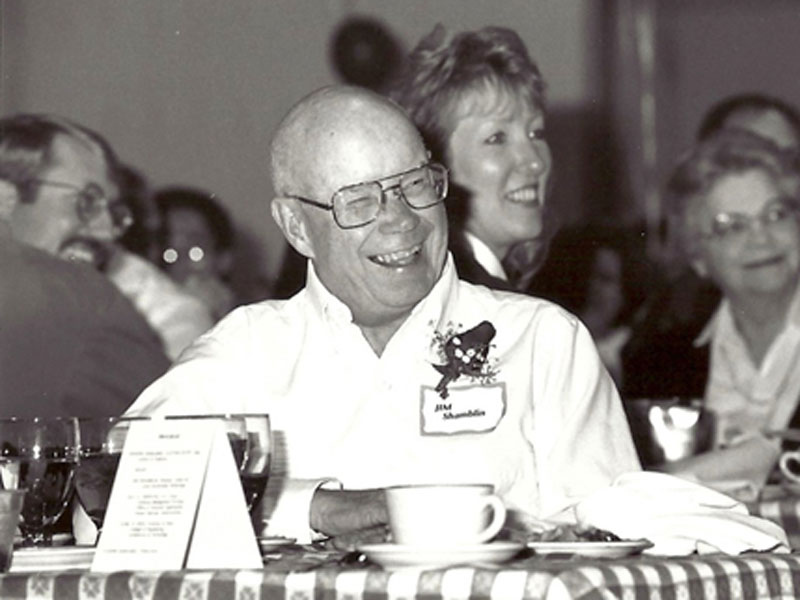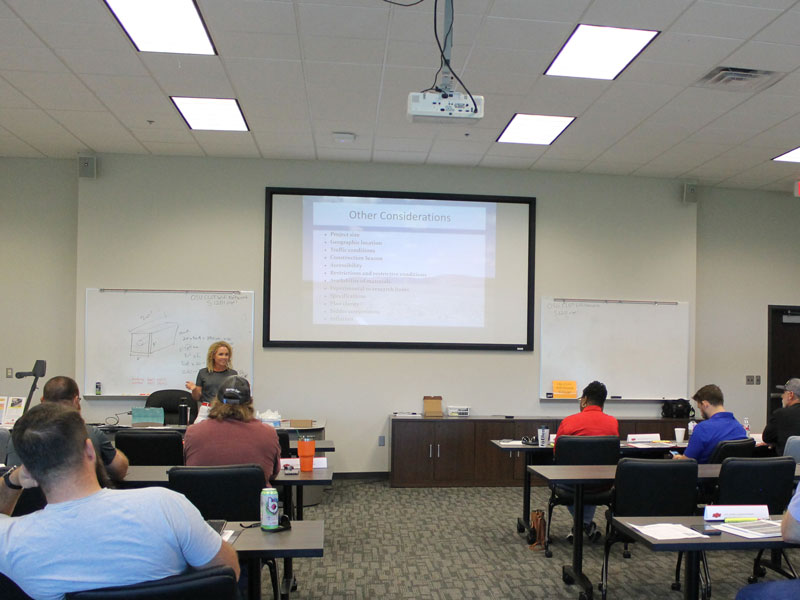
CLGT director, LTAP program manager look at history of both programs as they approach milestone anniversaries
Monday, December 5, 2022
Media Contact: Kristi Wheeler | Manager, CEAT Marketing and Communications | 405-744-5831 | kristi.wheeler@okstate.edu
This year, the Center for Local Government Technology (CLGT) celebrates 50 years of devoted service to Oklahoma citizens.
CLGT offers high quality educational programs, training, technical assistance and customized services to groups who specialize in serving the public. Programs offered through the center include the Assessor Training Accreditation Program (ATAP), the County Computer Assistance Program (CCAP), the Computer Assisted Mass Appraisal Program (CAMA) and the Local Technical Assistance Program (LTAP)
LTAP was one of the first programs established through the center and one of the first four centers in the United States. The LTAP program manages the Transportation Research Internship Program (TRIP) and the Oklahoma Pilot Escort Certification Program, as well as many other transportation related classes. LTAP will be celebrating 40 years of service this year.
To truly get an appreciation for how much of an impact CLGT and its LTAP program have on Oklahoma, the Oklahoma State University College of Engineering, Architecture and Technology (CEAT) reflects on the history of how the center came to be and what these programs offer.
CLGT: Helping small towns
The year was 1972, and the School of Industrial Engineering and Management (IEM) was undergoing some changes.
“I was a professor in industrial engineering and we had a new department head. The dean wanted the School of Industrial Engineering and Management to bring in more outside research dollars,” Dr. Jim Shamblin said in a 2002 video interview.
Shamblin began looking at what IEM could do to provide themselves a research niche that would make them competitive with larger schools.
“One of the things that we looked at was applying engineering technology to small towns and local governments,” Shamblin said. “We worked with our department head, Dr. [Joe] Mize, to put together a proposal to the National Science Foundation (NSF).”
The goal of the proposal was to see if Shamblin could take engineering research and training expertise out to Oklahomans. He had a vision of mimicking the university’s agricultural cooperative extension program, said Gary Snyder, the current director of CLGT.
Shamblin was successful in obtaining the grant, and after the conclusion of the grant he was able to successfully partner with the Oklahoma governor’s office to secure the program’s future.
CLGT’s main mission is to assist county officers and employees; tribal governments and members; municipal officers and employees; state agencies; and professional associations with whatever training or technical support they may need to continue to successfully serve Oklahomans.
The first program established under CLGT was the County Training Program, now called the County Government Training Program.
Scott Warren, CLGT’s former IT supervisor, developed the computerized Assessment Administration program to generate assessments and tax rolls with a personal computer, Snyder said.
“This CAMA project generated a number to represent the fair market value for properties,” Snyder said. “The computerized Assessment Administration program and the CAMA software needed to be compatible with each other and Scott was instrumental in making that happen.”
In 2019, 30 years after the initial CAMA software was released, former Oklahoma Gov. Mary Fallin signed the CAMA Bill, which provided permanent funding for CLGT to continue supporting ATAP, as well as to secure an updated CAMA software system so that county assessors could continue to appropriately and accurately appraise property.
“About 80 to 85 percent of the tax dollars that individuals pay goes to support common education, including career techs, so it is important that property assessments across the state are equitable.” Snyder said. “Part of the CAMA Bill allowed us to secure the new LandMark GSI software that county assessors use, as well as to train and support assessors in using the software so that assessments across the state are fair and appropriate.”
Currently, 71 of Oklahoma’s 77 counties are using the updated CAMA software and are utilizing the support and training from CLGT that come with it.
The purpose of the program was to aid elected county government officers and their staff in learning how to perform their mandated duties more effectively, efficiently and with greater knowledge and awareness.
The program offered certification and accreditation courses for county commissioners, county clerks, court clerks, county sheriffs, county treasurers and county assessors. CLGT housed the entirety of the County Training Program until 2006 when the programs were split between OSU Extension and CLGT, with CLGT maintaining the Assessor Training and Accreditation Program (ATAP), which focuses on training for county assessors, deputies and board of equalization members.
County assessors in Oklahoma are required to go through the ATAP program, and will be removed from office if they don’t complete the requirements of the training. Legislation was passed in 1988 to computerize assessor offices with mapping standards, mapping hardware and mapping license software, called CAMA. That was when CLGT began developing the CAMA program team.
“Prior to CAMA, the county assessment roll was handwritten in huge, and I mean huge, books,” Snyder said.
LTAP: The road show
Another influential program, LTAP, also calls CLGT home. In 1980, Shamblin gave a presentation to the Federal Highway Administration (FHWA), asking them to consider using some of the technical support that CLGT could offer for counties and towns.
“County commissioners were the most logical to work with, since they had road building problems and it would be easier for us to visit with them about what might be able to be done,” Shamblin said. “I got a quote from a county commissioner that said, ‘If I received all of the information [about how to fix a road], I’d need an engineer to read it.’ So, we emphasized that part of the role of our job was to interpret the problems of the local government and the technology that they had available and put it in terms they could use.”
John Hopkins, one of the future directors of Oklahoma’s Rural Technical Assistance program (RTAP), created a handbook on road maintenance and repair for county commissioners. When Shamblin presented the synopsis of the program to FHWA, they decided to start a series of 10 different centers based on the presented program. In 1984, FHWA established Oklahoma’s RTAP program within CLGT. It was one of the first four RTAP programs in existence.
RTAP has become LTAP, but the program’s mission remains to provide extension programs and services to those responsible for the construction and maintenance of transportation systems at the local level in Oklahoma. Their vision is to enable county, municipal and tribal governments to provide a better quality of life for the individuals that they serve.
Oklahoma’s LTAP is funded partially by the FHWA and partially by the Oklahoma Department of Transportation and offers free training courses to individuals working in the transportation field.
“The idea behind LTAP is to train transportation workers or those in the transportation field in everything from how to fill a pothole, to operating heavy machinery, and utilizing machinery to fight wildfires, to incident command in an incident where an individual working for the county and a first responder are both involved,” said Kim Johnson, LTAP program manager.
FHWA has four areas of expertise that LTAP focuses on training for, including organizational excellence, workforce development, safety and infrastructure.
A program highlight for LTAP is the Oklahoma Pilot Escort Program. LTAP is the only entity certified in the state and the only certified training class in the state that the Department of Public Safety recognizes for Pilot Escort certification. The course focuses on individuals who drive the vehicles that escort heavy trucks that typically haul wide loads.
While the Pilot Escort Program is one of the few classes in LTAP that course participants must pay to attend, the program is so strong that the certification is recognized in eight different states.
“Pilot Escort Program participants come from all over to take this course, and it is very exciting for our certification program to be recognized in so many different states,” Johnson said.
LTAP oversees the Roads Scholar Program, which is an educational certification series consisting of eight courses and 112 hours of instruction and laboratory experience, offered to county, municipal and tribal government elected officials and their employees. The courses cover the technical aspects of planning, maintaining and constructing roads and bridges at the local and tribal government level.
LTAP houses the Transportation Research Internship Program that places students from transportation related degree fields, many being from CEAT, in paid summer internships with local government agencies responsible for the construction, maintenance, design and planning of transportation systems.
A Grand Anniversary Celebration
Shamblin passed away in 2010, but his vision for CGLT and the programs it houses has continued to grow.
Thousands of Oklahomans benefit from CLGT and its programs, from the economic impact in terms of money saved through training received to make government operations more efficient, to lives saved through the safety training programs offered.
This year, CLGT and LTAP plan to host a celebration event in honor of their 50th and 40th year in service, respectively.
We are passionate about what we do,” Snyder said. “No two days are the same, and every day is a new day. We could have a county assessor call the office and say, ‘Can you come down and help me, my system is broken?’ And we are going to send someone to help. Additionally, it’s a big deal for the FHWA to support the LTAP program all these years because they see the need for training at the local and state level for transportation related issues.
“These anniversaries are exciting. Dr. Shamblin’s vision has come to pass.”
A Celebration of Storied History










Photos: Dakota Keith, Kristi Wheeler and provided
Story by: Dakota Keith | IMPACT Magazine
